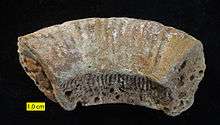Zombie taxon
In paleontology, a zombie taxon[1][2] (plural zombie taxa) or the zombie effect refers to a fossil, such as a dinosaur tooth, that was washed out of sediments and re-deposited in rocks and/or sediments millions of years younger.[3] That basic mistake in the interpretation of the age of the fossil leads to its title,[4] in that the discovered fossil was at some point mobile (or "walking") despite the original organism having been long dead. When that occurs, the fossil is described as a "reworked fossil" or remanié.
See also
- Convergent evolution
- Dead Clade Walking
- Extinction
- Elvis taxon
- Lazarus taxon
- Living fossil
Further reading
- Archibald, J. David. (1996). Dinosaur Extinction and the End of An Era. Columbia University Press, 672-684. ISBN 0-231-07625-8, who defined the terms zombie effect and zombie taxon/taxa.
- Weishampel, David B. et al. (2004). The Dinosauria. University of California Press. ISBN 0-520-24209-2.
- Abigail Lane et al. "Estimating paleodiversities: a test of the taxic and phylogenetic methods".
References
- Archibald, J. David (1996). Dinosaur Extinction and the End of An Era. Columbia University Press. ISBN 0-231-07625-8.. Retrieved on 2008-07-17.
- Lane, Abigail; Janis, Christine M.; Sepkoski, Jr., J. John (January 2005). "Estimating paleodiversities: a test of the taxic and phylogenetic methods". Paleobiology. 31 (1): 21–34. doi:10.1666/0094-8373(2005)031<0021:EPATOT>2.0.CO;2.
- Archibald, David (2007-03-24). "Zombie Origins". New Scientist. 2596: 27. doi:10.1016/s0262-4079(07)60736-2. Retrieved 2008-07-17.
- Weishampel, David B.; Dodson, Peter; Osmólska, Halszka (2004). The Dinosauria. University of California Press. p. 679. ISBN 0-520-24209-2. Retrieved 2008-07-17.
This article is issued from Wikipedia. The text is licensed under Creative Commons - Attribution - Sharealike. Additional terms may apply for the media files.
